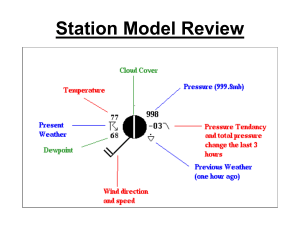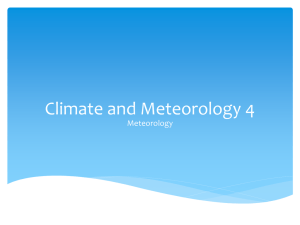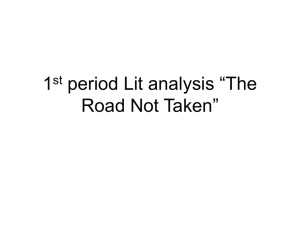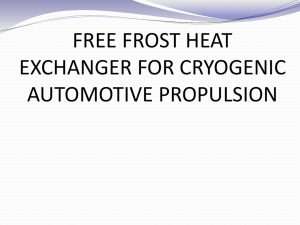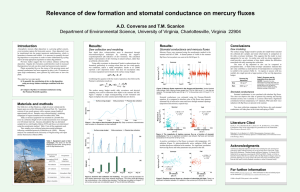Frosts, Freezes and Fretting
advertisement
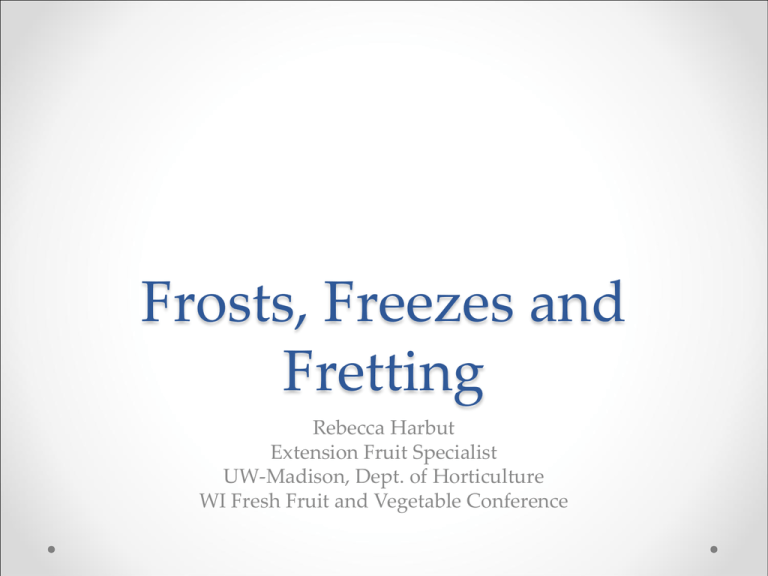
Frosts, Freezes and Fretting Rebecca Harbut Extension Fruit Specialist UW-Madison, Dept. of Horticulture WI Fresh Fruit and Vegetable Conference • Basics of Frost Protection…the easy stuff • Types of freeze and frost events • Anatomy of Frost • Frost Monitoring • Manipulating the landscape • Protection Mechanisms • It is possible to protect crops from most frost events, but other considerations often influence the choice • Economics: o Crop value o Expenses o Current debt load • Environment: o Resource use o pollution • Horticulture: o Long term Physiological/physical effects on crop Start with the Easy Stuff… Site Selection • The best frost protection technique is to choose the right site Cold Air Drainage: Wind Breaks and Obstacles Obstacles that slow or prevent the movement of cold air can be Good or Bad! Cold Air Drainage • Prune trees and vines to avoid blocking cold air from draining away from the vines • Prune out lower portions of windbreaks to allow air to pass through (unless the windbreak is also keeping cold air out) • Be mindful of where obstructions are placed to ensure they are not blocking movement of cold air Types of Frost Events National Weather Service Frost Advisories • minimum temperatures of 32-350 F are expected for several hours. Freeze Warnings • minimum temperatures around 300 F (or lower) are expected for several hours. Advection Freeze • Advection- transfer of heat (or cold, humidity) by the horizontal movement of an air mass • Dry, cold air mass moves in • Plant tissue is warmer than air Advection Freeze • Very difficult to protect crop • Any inputs of heat into the vineyard (ie. burners) are quickly blown away • DO NOT use wind machines! • Overhead irrigation can be used but MUST supply large volumes of water o insufficient water can quickly cause much worse damage that doing nothing at all Radiation Frost • Clear, dry air • Little or no wind • Plant tissue ‘radiates’ heat into space and becomes colder (2-4oF colder than air) o Plant tissue directly exposed to sky (top of canopy) become coldest o Warm air tries to warm plant an becomes colder and settles to the ground Radiation Frost 34-40oF 30oF 50 ft 6 ft Bud Cooling During Radiation Frost • Rate of plant tissue cooling can be very fast until the temperature approaches the dew point temperature o Dew Point Temperature = The temperature at which condensation of the water vapor in the air first occurs. Heat of Condensation • The formation of condensation (dew) on the tissue releases heat which temporarily stops/slows the tissue cooling • At the dew point temperature: o The exposed tissue will generally be the same temperature as the air o The rate of cooling is much slower because the heat of condensation replaces some of the radiative heat loss Rate of Cooling During Radiation Frost Example 1: Air Temp = 35oF, Dewpoint Temp=33oF o Temperature will drop quickly until it reaches 33oF when condensation will form on the buds. o Heat of condensation will compensate for some radiative heat loss and slow the rate of cooling Example 2: Air Temperature =35oF, Dewpoint= 27oF o Temperature will drop quickly until it reaches 27oF o Damage to buds can occur quickly, so protective measures must be started earlier Dew Point • Dew point is always lower than or equal to the air temperature o If air temperature continues to fall lower than the initial dew point, more water condenses and the dew point is also lowered • Dew Point Vs. Relative Humidity o Relative humidity is a relative measure of air moisture Temperature (oF) Dew Point (oF) Relative Humidity 90 80 67% 100 80 47% 110 80 33% Dew point is the most critical measure to understand when frost protecting Critical Temperature and Dew Point • Critical temperature - the temperature at which buds and/or other plant tissues (cells) will be killed. • If dew point is below the critical temperature, rate of cooling will be very fast and bud kill will occur quickly o No time to ponder the approach…get some protection! o If using irrigation for protection, must be sure not to start too late or buds can super cool • If dew point is above the critical temperature, the rate of bud cooling will be slower as it approaches the critical temperature o More time to consider and monitor conditions Principles of Protection During Radiation Frost 34-40oF 30oF 50 ft 6 ft Mix warm air from above inversion layer with cold air below Methods of Protection During Radiation Frost • Site Selection • Heat o Heaters • Wind o Wind machines o Helicopters • Water o Sprinklers • Covers Heaters 34-40oF 50 ft Plants must be in direct line of sight with heaters Heats up air inside inversion layer 30oF 6 ft Heaters • Advantages o Can be effective under freeze conditions - much of the heat will be blow out of vineyard • Disadvantages o o o o Expensive- need many Fuel Labor intensive environmental Bonfire 34-40oF 30oF 50 ft 6 ft Intense heat in one area can break the inversion layer Smoke Will not help in a frost event - will show where the inversion layer is 34-40oF 30oF 50 ft 6 ft Wind Machines • Advantages o Cost effective o Can be effective during radiation frost • Dependent on inversion characteristics • Disadvantages o Efficacy is Dependent on inversion characteristics Wind Machines 34-40oF 30oF 50 ft 6 ft Wind Machines • Must be turned on before freezing temperatures are reached • Can cover a 10A area – head rotates to cover area o Area of protection is not circular due to wind drift • • • • • Highly dependent on temperature inversion Placement should be done by a professional Power source: gas, diesel, electric, PTO Can cause more damage during an advective freeze Cost ~ $30,000 for new Helicopters • Operate on the same principle as the wind machines • Not as sensitive to temperature inversion and height • Expensive > $500/hr • Must be able to return to areas every 6-8 mins to ensure air stratification do not reoccur Forced Air Displacement System • Force cold air up into atmosphere • Cost effective • PTO or Gas operated models Forced Air Displacement 34-40oF 30oF 50 ft 6 ft Sprinklers • Warm water gives up heat on contact with cold air and tissue • Latent heat of fusion- heat released when ice is formed Sprinklers • Cost effective • Set Up Options: o Overhead • Better frost protection • More ice build up • Increased leaf wetness if used for irrigation o Micro Sprinklers • Less frost protection • No issues with ice build up • More efficient for irrigation Considerations for Sprinkler Use • Water quantity o Irrigation must run during the entire frost event • Irrigation turned on for frost protection when irrigation not necessarily needed o Consider soil characteristics o Heavy soil – low output sprinklers • Weight of ice on vines can cause damage Dew Point and Sprinkler Use • In dry conditions (dew point 5oF below predicted low air temperature): o water applied to tissue will evaporate causing evaporative cooling of tissue o Tissue can become colder than surrounding air- more damage than doing nothing at all Other Frost Protection Methods • Covers o Several types: spunbonded fabrics, plastic o Can be effective during advective freeze due to wind protection o During radiative frost- tissue touching poly film may be more damaged • Spray o Ice nucleating bacteria sprays, nutrient and hormonal sprays, etc. o No conclusive evidence of their efficacy Summary • Choose your site and design your vineyard wisely! • Understand the forecast o Advective freeze (pray) OR Radiation frost • Understand the dew point! • Install temperature monitoring equipment o Inversion pole o Thermometers throughout the vineyard • Consider economics

